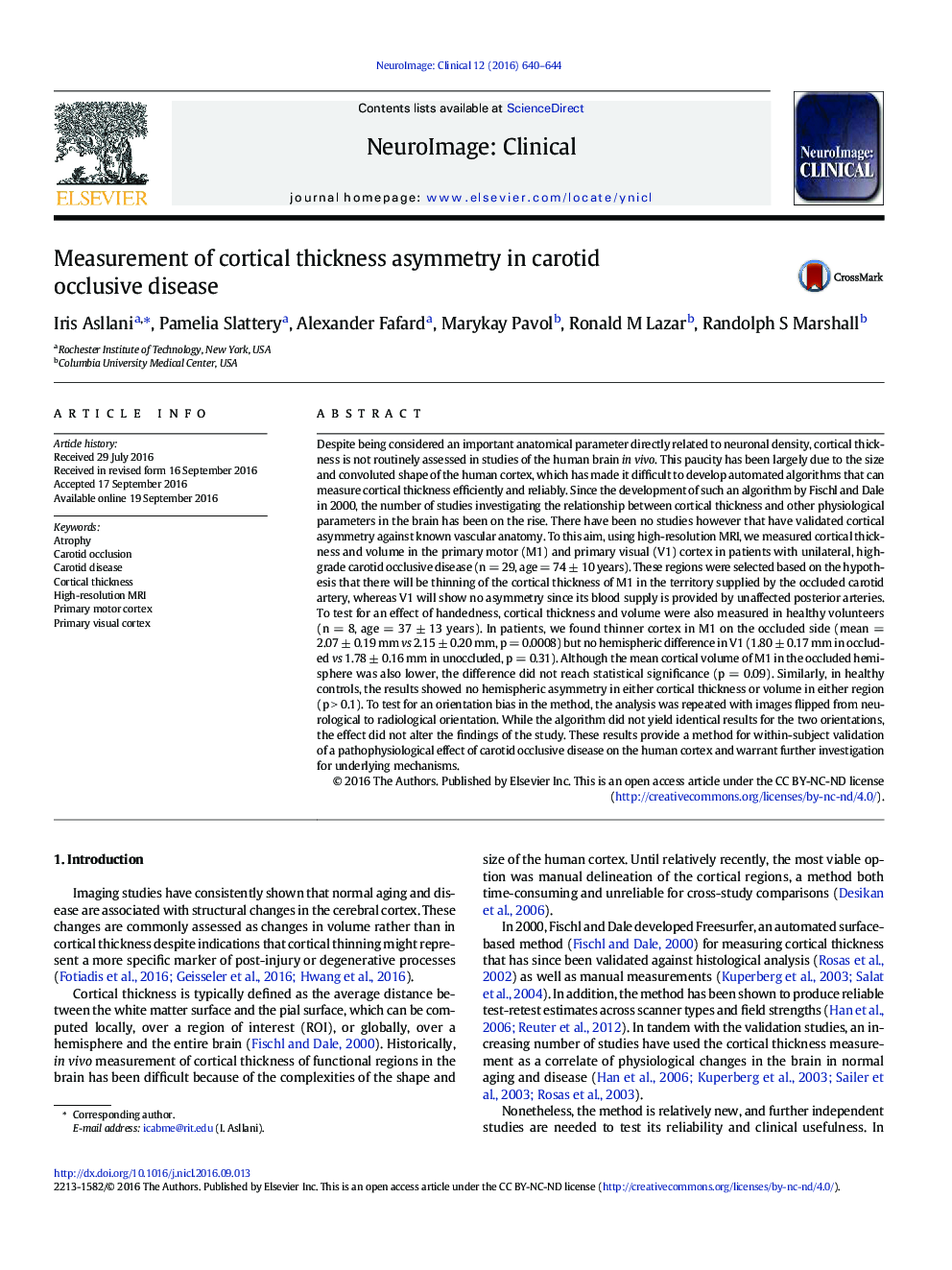| کد مقاله | کد نشریه | سال انتشار | مقاله انگلیسی | نسخه تمام متن |
|---|---|---|---|---|
| 8688966 | 1580955 | 2016 | 5 صفحه PDF | دانلود رایگان |
عنوان انگلیسی مقاله ISI
Measurement of cortical thickness asymmetry in carotid occlusive disease
ترجمه فارسی عنوان
اندازه گیری عدم تقارن ضخامت قشر در بیماری انسداد کاروتید
دانلود مقاله + سفارش ترجمه
دانلود مقاله ISI انگلیسی
رایگان برای ایرانیان
کلمات کلیدی
موضوعات مرتبط
علوم زیستی و بیوفناوری
علم عصب شناسی
روانپزشکی بیولوژیکی
چکیده انگلیسی
Despite being considered an important anatomical parameter directly related to neuronal density, cortical thickness is not routinely assessed in studies of the human brain in vivo. This paucity has been largely due to the size and convoluted shape of the human cortex, which has made it difficult to develop automated algorithms that can measure cortical thickness efficiently and reliably. Since the development of such an algorithm by Fischl and Dale in 2000, the number of studies investigating the relationship between cortical thickness and other physiological parameters in the brain has been on the rise. There have been no studies however that have validated cortical asymmetry against known vascular anatomy. To this aim, using high-resolution MRI, we measured cortical thickness and volume in the primary motor (M1) and primary visual (V1) cortex in patients with unilateral, high-grade carotid occlusive disease (n = 29, age = 74 ± 10 years). These regions were selected based on the hypothesis that there will be thinning of the cortical thickness of M1 in the territory supplied by the occluded carotid artery, whereas V1 will show no asymmetry since its blood supply is provided by unaffected posterior arteries. To test for an effect of handedness, cortical thickness and volume were also measured in healthy volunteers (n = 8, age = 37 ± 13 years). In patients, we found thinner cortex in M1 on the occluded side (mean = 2.07 ± 0.19 mm vs 2.15 ± 0.20 mm, p = 0.0008) but no hemispheric difference in V1 (1.80 ± 0.17 mm in occluded vs 1.78 ± 0.16 mm in unoccluded, p = 0.31). Although the mean cortical volume of M1 in the occluded hemisphere was also lower, the difference did not reach statistical significance (p = 0.09). Similarly, in healthy controls, the results showed no hemispheric asymmetry in either cortical thickness or volume in either region (p > 0.1). To test for an orientation bias in the method, the analysis was repeated with images flipped from neurological to radiological orientation. While the algorithm did not yield identical results for the two orientations, the effect did not alter the findings of the study. These results provide a method for within-subject validation of a pathophysiological effect of carotid occlusive disease on the human cortex and warrant further investigation for underlying mechanisms.
ناشر
Database: Elsevier - ScienceDirect (ساینس دایرکت)
Journal: NeuroImage: Clinical - Volume 12, February 2016, Pages 640-644
Journal: NeuroImage: Clinical - Volume 12, February 2016, Pages 640-644
نویسندگان
Iris Asllani, Pamelia Slattery, Alexander Fafard, Marykay Pavol, Ronald M Lazar, Randolph S Marshall,
